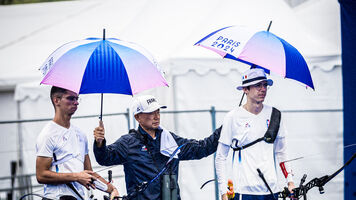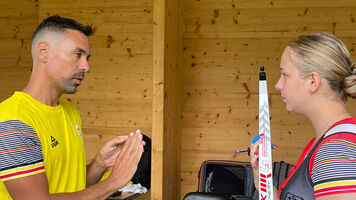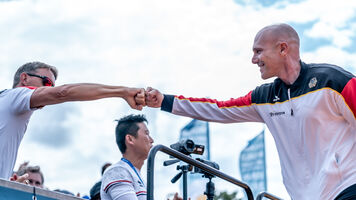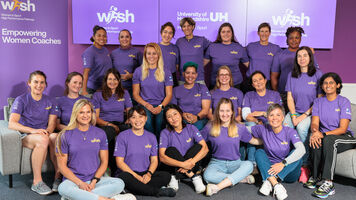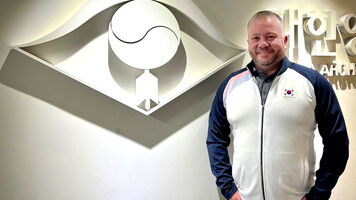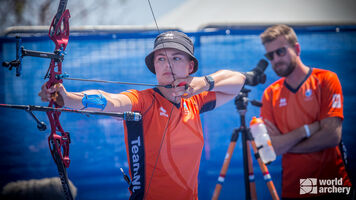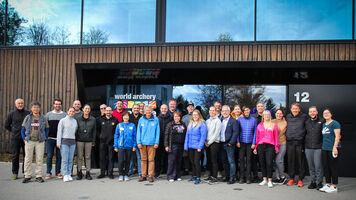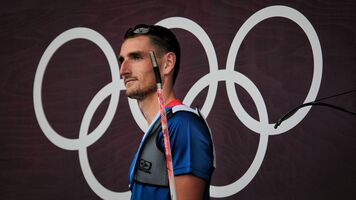How Yusuf Goktug Ergin reset archery culture in Türkiye

It wasn’t too long ago that one Yusuf Goktug Ergin was a recurve archer himself.
The 40-year-old made his competitive international senior debut in 2005 at a European Grand Prix in Bulgaria, before making an Olympic appearance in Beijing 2008 and then retiring three years later after the 2011 World Archery Championships.
Ergin did not win an international medal, but it is management that has proven to be his calling in archery. Starting off as a coach in 2016 for his home nation of Türkiye, Ergin is now the country’s technical director and national head coach.
Türkiye had never won an Olympic archery medal before his arrival, with the last world championship podium finish coming in Victoria 1997 (women’s team bronze).
Eight years in, under Ergin Türkiye has an Olympic gold medal to its name - via Mete Gazoz in Tokyo 2020 – and three world championship podium finishes: mixed team bronze in Yankton 2021, Gazoz men’s individual gold in Berlin 2023 and men’s team silver also in Berlin 2023.
Ergin simply puts this sharp return in major tournaments down to implementing the “base of training science”, but the level of work and attention to detail that has gone into it makes it no wonder that Türkiye is now a force to be reckoned with on the global archery stage.
“The situation was really difficult when I joined the team,” said Ergin on the start of his tenure. “We were just at the beginning of the changing of generations.”
“Most of the good archers were at the end of their careers and because of the wrong policies, we didn’t have the young archers in good shape.”
He also revealed that before himself, the Turkish archery federation was looking to appoint a foreign coach, but Ergin knew to win major international medals was “impossible” without newcomers.

Therefore, giving Türkiye a refreshing, new look was an imperative for Ergin, which is why he went to as young as the under 15 level, discovering the likes of Gazoz and 2018 European Champion Yasemin Anagoz.
Whilst trying to develop young talents, Ergin was also in the process of completely resetting not only the archery system in the country but the culture.
“The training concept was like recreation for archery in Türkiye,” said Ergin on why he felt a change was needed. “I just tried to put some training science and athletic concept inside it.”
Organising longer, prolonged training camps for the senior team was another difference instilled by Ergin, almost creating what he called a “residential system”, when athletes are based at training centres for fixed periods of the year like in nations such as Korea.
It was not just training time Ergin wanted to change, however.
“The main problem was that local coaches didn’t have training science education,” he added. “Everybody knows how to shoot but I tried to convince them knowing how to shoot is not enough to win.”
“You have to be strong enough to win.”
On the face of it, archery is recognised as a sport, therefore its participants are known as athletes.
But as strength and conditioning was not at the forefront of his predecessors’ minds, Ergin has made being “strong enough” a priority in his archers’ training.

Daily in Türkiye’s camps, physical exercises related to archery form and technique are now enforced.
At the 2022 World Archery Coaching Conference, Ergin displayed an example of what a training day consisted for his archers.
It shows the relentless, intense nature of what being a high performing archer entails: 480 arrows shot per archer from seven in the morning to six in the evening, combined with exercises such as push ups and wall sits with an hour sandwiched in between dedicated to strength and conditioning.
It totals 10 hours of training for both men and women recurve archers.
On top of this, every single arrow, heartbeat, exercise and mental numerical is extensively recorded by sports scientists. You name it, Ergin and his staff will know it.
Not only did this approach maximise efforts from the crop of archers Ergin began with but propelled the younger talents.
“At the end, the older athletes just couldn’t resist the younger ones’ scores,” said Ergin. “So, we made a natural transformation. Now our athletes have a much more different mindset about the archery training.”
Ergin also says that training techniques are reviewed every year and changes are regularly made but the concept behind every session “has to be athletic”.
“Of course, every year I have to implement some new details, otherwise I cannot run out monotony and over training issues.”
“For now, we have really tight schedule for each day, but the athletes are enjoying this kind of training.”

Despite all the world class athletic data analysis they now have over all of Türkiye’s national team, the willingness to repeatedly go through an intense physical and mental period a training camp brings can only go so far, especially if the incentive is not there.
The next step for Ergin now is not only to continuously improve the stringent, detailed training system he has brought in but to sustain it, and the high performing athletes it suits.
“They get good bonuses if they win the competitions, but we have to convert it to provide funding for the athletes’ preparation period.”
“As a federation we cover all their expenses for accommodation and nutrition but as they get older, they would need much more than this.”
“If we can provide more funding, their mindset will be stronger,” he concluded.
The roadmap Ergin initially set out has worked to a tee. Revitalising archery in a country that had failed to see one of its own climb up onto an Olympic or World Championship podium in 24 years.
Both these weights have been lifted off Türkiye’s shoulder.
But elite organisations are always evolving, even more so in sport with its transient nature.
So, Ergin’s roadmap is changing, and the mission to make sure Türkiye’s recent fortunes aren’t a fad, is on.




